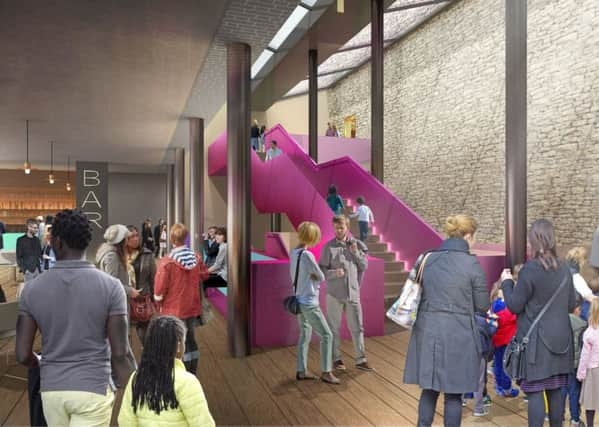The Citizens' Theatre company prepares to hit the road as its Gorbals home gets a major refit


Next year, though – and the one after – the Citizens’ company will not be at home in Gorbals Street, come Christmastime; because if all goes well, and two final large tranches of money can be slotted into place, the company will be moving out, from next summer, to make way for a massive two-year £20 million building project, which will leave the Citizens’ much-loved auditorium untouched, but will transform the building around it. The aim of the project is to make the theatre fit for the 21st century; and it will involve restoring its fast-collapsing south wall, knocking down the makeshift range of offices to the north side, and creating a long, glowing new two-storey glass frontage on Gorbals Street, behind which there will be a new and more spacious cafe-bar, a new studio theatre, a much-needed community theatre area, and brand new rehearsal rooms.
There will also be lifts to all areas, and vastly improved wheelchair access; and along the rebuilt south side of the building, on the line of the old close after which the Citizens’ famous Close Theatre studio was named, there will long public corridors on both floors running the full depth of the building, allowing a public view of the set-building workshops, and – on the lower level – of the Citizens’ historic original stage machinery and wooden stage structure.
Advertisement
Hide Ad“I’m so delighted that we’re working with the architects Bennetts Associates on this,” says the Citizens’ executive director Judith Kilvington, “and particularly by that aspect of the design – I feel they’ve really thought about the original shape and history of the building, and tried to revive that sense of the public being able to walk right through to the back. The idea is to keep this beautiful Victorian building alive by repairing its structure, and providing it with all the facilities a 21st century theatre needs; and I think the plans we have do that beautifully.”
Bennetts Associates are among Britain’s leading theatre architects, responsible for the newly-reshaped Royal Shakespeare Theatre at Stratford-upon-Avon, among many other projects; and their new Citizens’ frontage – gleaming glass that reveals the old Victorian gable behind, with the Citizens’ famous statues of four Muses plus Shakespeare and Burns, salvaged from the demolition of its grand Victorian facade in the 1970s, once again ranged along the top – will transform the look of a theatre whose current 1990s foyer never quite seemed to match the glory of its auditorium.
The sheer scale of the building project, though, means that the company must move out for two years from June; and despite the challenges involved, both
Kilvington and Hill are looking forward to a period when the Citizens’ will have a chance to build new relationships with other arts organisations and venues across Glasgow, and to reach out to new and different audiences. From September 2018, the Citizens’ stage shows will mainly be presented at the Tramway in Albert Drive. The big community and learning department, under director Guy Hollands, will move to the beautiful Scotland Street School Museum, a Charles Rennie Mackintosh building which will next year be celebrating the 150th anniversary of Mackintosh’s birth; and the set-building, costume-making and administrative departments will move across the road to the former Skills Academy building, in an old primary school beside Bridge Street underground station.
“In creative terms, I’m absolutely excited by the prospects for the next couple of years,” says Hill, whose epic production of Zinnie Harris’s Oresteia: This Restless House was one of the hits of this year’s Edinburgh Festival. “I think the Citizens’ and the Tramway are two of the great theatre spaces in Glasgow, and it’s thrilling to be able to explore the potential of moving our work there. For the kind of large-scale epic theatre we love, Tramway 1 is an ideal space, and I’m looking forward to exploring its flexibility, and the opportunity it offers to change the relationship between the stage and the audience.”
It’s already been announced that Hill’s first production at the Tramway will be a large-scale new staging of the late Scottish Makar Edwin Morgan’s acclaimed 1996 version of Cyrano De Bergerac. And meanwhile, for the next six months at least, the show in the Gorbals goes on, with barely a pause for breath; as we speak, Dominic Hill is heading off to audition for the Citizens’ spring production of A Long Day’s Journey Into Night.
Advertisement
Hide Ad“Of course, there are always anxieties about a building project on this scale,” says Hill, who admits that he’s not quite sure where his temporary office space will be when the big move takes place. “But basically, I just feel that I’m lucky. Lucky to be working with a wonderful executive director and a great team, lucky to be directing Cinderella one week, and then focussing on Eugene O’Neill the next. And lucky to have the chance to move from one great Glasgow theatre space to another; and to enjoy whatever new possibilities that brings, over the next two years.” ■
The Citizens’ spring season opens in January; details at www.citz.co.uk